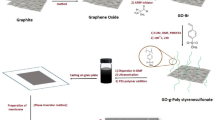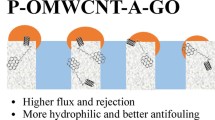Abstract
Recently, there is a high demand for development of polymeric membrane for their widespread technological applications. Polymer blends incorporation with inorganic composite particles is the most effective strategy for obtaining antifouling, antibacterial, gas and water permeable membrane materials. However, their biological and surface properties are always hindered by the inefficient interaction of filler into polymer matrix because it is distributed into the bulk membrane matrix. In this study, graphene oxide nanosheets are incorporated with metal (Ag)/metal oxide (ZnO) composite filler (MGO) followed by surface modification with quaternary cetyltrimethylammonium bromide (CTAB) to enhance non-covalent interactions between filler and poly methyl methacrylate (PMMA)/polyethylene glycol (PEG) blend membrane. The membrane was utilized for improving antifouling, antibacterial and gas permeability of membrane. Our results indicated that CTAB-modified filler (CTAB@MGO) was bonded to the polymer blend membrane without affecting the membranes’ physicochemical properties. The prepared CTAB@MGO–PMMA/PEG membrane showed excellent antibacterial property against model Escherichia coli bacteria. The antifouling activity and CTAB stability results of modified blend membrane ensured reduced bovine serum albumin adsorption and slow dissociation of surfactant molecules, respectively. The CTAB@MGO–PMMA/PEG blend membrane also showed promising gas permeability results with hydrogen (H2), nitrogen (N2) and carbon dioxide (CO2). The presented approach highlights the potential of surface modification of filler and introduces them in polymeric membrane as a simple, easy and cost-effective strategy for preparing antifouling and gas/water permeable polymeric membranes.








Similar content being viewed by others
References
Dong L et al (2016) Enhanced CO2 separation performance of P (PEGMA-co-DEAEMA-co-MMA) copolymer membrane through the synergistic effect of EO groups and amino groups. RSC Adv 6(65):59946–59955
Das S, Banthia A, Adhikari B (2006) Removal of chlorinated volatile organic contaminants from water by pervaporation using a novel polyurethane urea–poly (methyl methacrylate) interpenetrating network membrane. Chem Eng Sci 61(19):6454–6467
Álvarez-Paino M, Muñoz-Bonilla A, Fernández-García M (2017) Antimicrobial polymers in the nano-world. Nanomaterials 7(2):48
Munoz-Bonilla A, Fernández-García M (2012) Polymeric materials with antimicrobial activity. Prog Polym Sci 37(2):281–339
Munoz-Bonilla A, Fernandez-Garcia M (2015) The roadmap of antimicrobial polymeric materials in macromolecular nanotechnology. Eur Polym J 65:46–62
Sarı A et al (2010) Poly (ethylene glycol)/poly (methyl methacrylate) blends as novel form-stable phase-change materials for thermal energy storage. J Appl Polym Sci 116(2):929–933
Silvestre C, Duraccio D, Cimmino S (2011) Food packaging based on polymer nanomaterials. Prog Polym Sci 36(12):1766–1782
Bi H et al (2006) Deposition of PEG onto PMMA microchannel surface to minimize nonspecific adsorption. Lab Chip 6(6):769–775
Landis RF et al (2016) Cross-linked polymer-stabilized nanocomposites for the treatment of bacterial biofilms. ACS Nano 11(1):946–952
Yu W et al (2014) Pre-treatment for ultrafiltration: effect of pre-chlorination on membrane fouling. Sci Rep 4:6513
Helin H et al (2008) Anti-fouling ultrafiltration membrane prepared from polysulfone-graft-methyl acrylate copolymers by UV-induced grafting method. J Environ Sci 20(5):565–570
Liu Y et al (2016) Enhanced membrane antifouling and separation performance by manipulating phase separation and surface segregation behaviors through incorporating versatile modifier. J Membr Sci 499:406–417
Huang X et al (2016) Low-fouling antibacterial reverse osmosis membranes via surface grafting of graphene oxide. ACS Appl Mater Interfaces 8(23):14334–14338
Sharma M, Madras G, Bose S (2015) Unique nanoporous antibacterial membranes derived through crystallization induced phase separation in PVDF/PMMA blends. J Mater Chem A 3(11):5991–6003
Fang L-F et al (2017) Structures and antifouling properties of polyvinyl chloride/poly (methyl methacrylate)-graft-poly (ethylene glycol) blend membranes formed in different coagulation media. J Membr Sci 524:235–244
Hwangbo K-H, Kim Y-J, Cho KY (2012) Fabrication of protein-resistant blend based on PVDF-HFP and amphiphilic brush copolymer made from PMMA and PEGMA. Appl Surf Sci 263:291–296
Zhang R et al (2016) Antifouling membranes for sustainable water purification: strategies and mechanisms. Chem Soc Rev 45(21):5888–5924
Ma X-Y, Zhang W-D (2009) Effects of flower-like ZnO nanowhiskers on the mechanical, thermal and antibacterial properties of waterborne polyurethane. Polym Degrad Stab 94(7):1103–1109
Patricio P et al (2006) Effect of blend composition on microstructure, morphology, and gas permeability in PU/PMMA blends. J Membr Sci 271(1–2):177–185
Hong R, Chen Q (2014) Dispersion of inorganic nanoparticles in polymer matrices: challenges and solutions. In: Kalia S, Haldorai Y (eds) Organic–inorganic hybrid nanomaterials, vol 267. Springer, Cham, pp 1–38
Hanemann T, Szabó DV (2010) Polymer-nanoparticle composites: from synthesis to modern applications. Materials 3(6):3468–3517
Li Y et al (2013) Crystallization of poly (ethylene glycol) in poly (methyl methacrylate) networks. Mater Sci 19(2):147–151
Matai I et al (2014) Antibacterial activity and mechanism of Ag–ZnO nanocomposite on S. aureus and GFP-expressing antibiotic resistant E. coli. Colloids Surf B 115:359–367
Bharadwaj S et al (2018) Graphene nano-mesh-Ag-ZnO hybrid paper for sensitive SERS sensing and self-cleaning of organic pollutants. Chem Eng J 336:445–455
Ravichandran K et al (2016) Realizing cost-effective ZnO: Sr nanoparticles@ graphene nanospreads for improved photocatalytic and antibacterial activities. RSC Adv 6(72):67575–67585
Kavinkumar T, Manivannan S (2016) Uniform decoration of silver nanoparticle on exfoliated graphene oxide sheets and its ammonia gas detection. Ceram Int 42(1):1769–1776
Upadhyay RK, Soin N, Roy SS (2014) Role of graphene/metal oxide composites as photocatalysts, adsorbents and disinfectants in water treatment: a review. RSC Adv 4(8):3823–3851
Fu Y-J et al (2006) Zeolite-filled PMMA composite membranes: influence of surfactant addition on gas separation properties. Desalination 200(1–3):250–252
Mallakpour S, Jarang N (2018) Production of bionanocomposites based on poly (vinyl pyrrolidone) using modified TiO2 nanoparticles with citric acid and ascorbic acid and study of their physicochemical properties. Polym Bull 75(4):1441–1456
Zhang X et al (2017) Membrane biofouling control using polyvinylidene fluoride membrane blended with quaternary ammonium compound assembled on carbon material. J Membr Sci 539:229–237
He M et al (2016) Zwitterionic materials for antifouling membrane surface construction. Acta Biomater 40:142–152
Olkowska E, Polkowska Z, Namiesnik J (2011) Analytics of surfactants in the environment: problems and challenges. Chem Rev 111(9):5667–5700
Tüzüner Ş, Demir MM (2015) Dispersion of organophilic Ag nanoparticles in PS-PMMA blends. Mater Chem Phys 162:692–699
Rana D, Matsuura T (2010) Surface modifications for antifouling membranes. Chem Rev 110(4):2448–2471
Kumar R, Kumar M, Awasthi K (2016) Functionalized Pd-decorated and aligned MWCNTs in polycarbonate as a selective membrane for hydrogen separation. Int J Hydrog Energy 41(48):23057–23066
Upadhyay S, Bagheri S, Hamid SBA (2014) Enhanced photoelectrochemical response of reduced-graphene oxide/Zn1 − xAgxO nanocomposite in visible-light region. Int J Hydrog Energy 39(21):11027–11034
Yoo D-H et al (2012) Photocatalytic performance of a Ag/ZnO/CCG multidimensional heterostructure prepared by a solution-based method. J Phys Chem C 116(12):7180–7184
Meng W et al (2015) Structure and interaction of graphene oxide–cetyltrimethylammonium bromide complexation. J Phys Chem C 119(36):21135–21140
Liu Q et al (2017) Enhanced mechanical and thermal properties of CTAB-functionalized graphene oxide–polyphenylene sulfide composites. High Perform Polym 29(8):889–898
Zhang Z, Lin M (2014) Fast loading of PEG–SH on CTAB-protected gold nanorods. RSC Adv 4(34):17760–17767
Shinzawa H, Mizukado J, Kazarian SG (2017) Fourier transform infrared (FT-IR) spectroscopic imaging analysis of partially miscible PMMA–PEG blends using two-dimensional disrelation mapping. Appl Spectrosc 71(6):1189–1197
Singh A, Chandra A (2013) Graphene and graphite oxide based composites for application in energy systems. Phys Status Solidi (b) 250(8):1483–1487
Thomas K et al (2008) Raman spectra of polymethyl methacrylate optical fibres excited by a 532 nm diode pumped solid state laser. J Opt A Pure Appl Opt 10(5):055303
Putz KW et al (2010) High-nanofiller-content graphene oxide–polymer nanocomposites via vacuum-assisted self-assembly. Adv Funct Mater 20(19):3322–3329
Barrer R, Rideal EK (1939) Permeation, diffusion and solution of gases in organic polymers. Trans Faraday Soc 35:628–643
Gacal BN, Filiz V, Abetz V (2016) The synthesis of poly (ethylene glycol)(PEG) containing polymers via step-growth click coupling reaction for CO2 separation. Macromol Chem Phys 217(5):672–682
Acknowledgements
The authors thank Dr. Kamlendra Awasthi for gas permeation characterization of samples. We thank Dr. S Bharadwaj and Ashish Pandey for their assistance in sample preparation and SEM imaging of samples.
Author information
Authors and Affiliations
Corresponding author
Electronic supplementary material
Below is the link to the electronic supplementary material.
Rights and permissions
About this article
Cite this article
Muhammad, S., Siddiq, M., Niazi, J.H. et al. Role of quaternary ammonium compound immobilized metallic graphene oxide in PMMA/PEG membrane for antibacterial, antifouling and selective gas permeability properties. Polym. Bull. 75, 5695–5712 (2018). https://doi.org/10.1007/s00289-018-2356-4
Received:
Revised:
Accepted:
Published:
Issue Date:
DOI: https://doi.org/10.1007/s00289-018-2356-4




